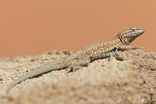| Celina - "A very common species that I particularly enjoy is the Six-Lined Racerunner (Aspidoscelis sexlineatus), due to the bright coloration they can get here in the plains. The juveniles are no exception, with their cobalt blue tails. They can be tricky to spot for more than a moment because they are quick and flighty, but if you're patient and careful you can usually snap a voucher photo before they decide they've had enough of your presence." | Devin - "This week was characterized by a front of cool weather spreading across the eastern plains of Colorado. Many species decided to seek shelter under ground, but I did happen upon a Prairie Rattlesnake towards the middle of the day when the temperature had reached it's peak. Ornate Box Turtles are a species that tends to be active in cooler temperatures than many other reptiles, and we did end up seeing a few of them as well." |
Beth - "Throughout the course of the summer we have seen a few crickets skewered on the prongs of barbed wire fences and recognized them as the work of a shrike. Before surveying some of our sites this week, we heard from landowners that Lesser Earless and Fence Lizards were being pierced on the barbed wire. I kept this in mind while we looked for what reptiles we could find in the cool weather. Then, as Devin and I were traveling from one site to another, I hopped out of our truck to open a gate. Next to the gate entrance was the head and neck of a small snake. Thoroughly confused, I waved for Devin to come take a look and he was just as surprised to see the head of this little snake on a gate we had gone through earlier not more than a few hours previously. Devin turned around and looked at the rest of the gate only to find the rest of the slim body stuck to another barb (see photos above). Remembering what we had heard about the lizards earlier, we concluded it must have been the work of a shrike. It took us a few minutes and some paging through a field guide to finally agree that the little snake was actually a juvenile Coachwhip (neither of us had ever seen the juvenile patterning of a Coachwhip). Often making appearances for split seconds on the road, we usually only see Coachwhips as adults so it was fascinating to see a juvenile stuck by a shrike on that gate!"
 RSS Feed
RSS Feed
